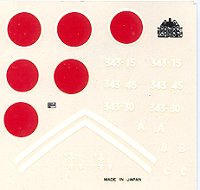
|
KIT: |
Hasegawa 1/72 N1K2-J Shiden-kai |
|
KIT # |
B1 |
|
PRICE: |
350 yen |
|
DECALS: |
Three options |
|
REVIEWER: |
Scott Van Aken |
|
NOTES: |

|
HISTORY |
This Japanese fighter was produced during the last year of WW II. Because of initial production problems, plus shortages of parts resulting from B-29 raids on the Japanese homeland, only 428 were produced. The airplane proved to be one of the best "all-round" fighters operational in the Pacific. However, it did not have sufficient performance at altitude to make it an effective interceptor against B-29 raids, primarily due to engine development difficulties.
A unique design feature was wing flaps which operated automatically to increase "lift" when necessary during extreme maneuvers. The device, operated with electricity and oil pressure using a U-shaped tube containing mercury, was an important factor in the aircraft's maneuverability in combat. There are several 'Georges' in various museums in the US, including the USAF Museum from which I pinched this historical intro.
|
THE KIT |

Hasegawa's second generation kits started popping out of the mold machines in the late 1970s and early 1980s. These kits had several improvements over the earlier, and clunkier moldings. For one thing, they now had engraved panel lines. They also had something of a more detailed cockpit where earlier it was a seat and pilot. There was also an enclosed wheel well and the gear doors were a single piece that one cut when doing a gear down model (which you had to do as there was no stand).
Overall, the quality improvement was a major leap from what had gone before and they were greeted with glad cries from modelers around the world. Of course, the price also increased as what used to be be 150 yen for a 'series B' type kit was now 350. We who were scarfing up Hasegawa kits realized that there were several different levels of kit with A the cheapest and generally smallest up to the K kits (like the Mavis and P-3 kits). Prices rose accordingly but were pretty close to the same within a series.
Anyway, this one is the George and is still probably the best 1/72 kit of its type around. There was an issue of a George by Aoshima in its short-lived higher quality run of kits, but I believe it was the N1K2 and not the N1K2-J variant.
This kit is not that much less detailed that today's Hasegawa 1/72 versions, but there is a difference and that is in the amount of detail. This one has a floor, seat, stick, instrument panel and pilot for the cockpit where a more modern Hasegawa kit would have side consoles and side panel detail as well. The engine is just a half front with some crankcase detail. The wheel wells are devoid of any kind of detailing. Canopy is a single piece and very well detailed, a big improvement over the previous kits. As with today's 1/72 Hasegawa kits, the instrument panel is supplied with a decal.
 The
dark green plastic does have ejector pin marks on the landing gear
struts, gear door interiors and the floor of the cockpit that will have
to go. No major sink areas that will be seen after the kit is done and no
flash. The instructions are completely in Japanese, but with these simple
kits, that is not a problem as the 6 construction drawings are well done.
The big problem for those who haven't been around a while is that you
have no idea what the colors are. No Gunze references; that will be years
down the road from this kit. However, many of us won't find that a
problem. The decals are thick and whites are ivory, just as Hasegawa
decals have been for years until very recently. Markings are for three
343 Kokutai aircraft. We now know that the unit codes and kill markings
were in yellow and not the white given in the sheet. The hinomarus seem a
bit too bright as well, but with many new aftermarket sheets for this
plane, that removes the markings problem.
The
dark green plastic does have ejector pin marks on the landing gear
struts, gear door interiors and the floor of the cockpit that will have
to go. No major sink areas that will be seen after the kit is done and no
flash. The instructions are completely in Japanese, but with these simple
kits, that is not a problem as the 6 construction drawings are well done.
The big problem for those who haven't been around a while is that you
have no idea what the colors are. No Gunze references; that will be years
down the road from this kit. However, many of us won't find that a
problem. The decals are thick and whites are ivory, just as Hasegawa
decals have been for years until very recently. Markings are for three
343 Kokutai aircraft. We now know that the unit codes and kill markings
were in yellow and not the white given in the sheet. The hinomarus seem a
bit too bright as well, but with many new aftermarket sheets for this
plane, that removes the markings problem.
|
CONCLUSIONS |
Still the best game in town for most modelers when it comes to this plane in 1/72. They are easy to find and can often be picked up at swap meets and other 'used kit' stores for around $5.
If you would like your product reviewed fairly and quickly by a site that has nearly 250,000 visitors a month, please contact me or see other details in the Note to Contributors.